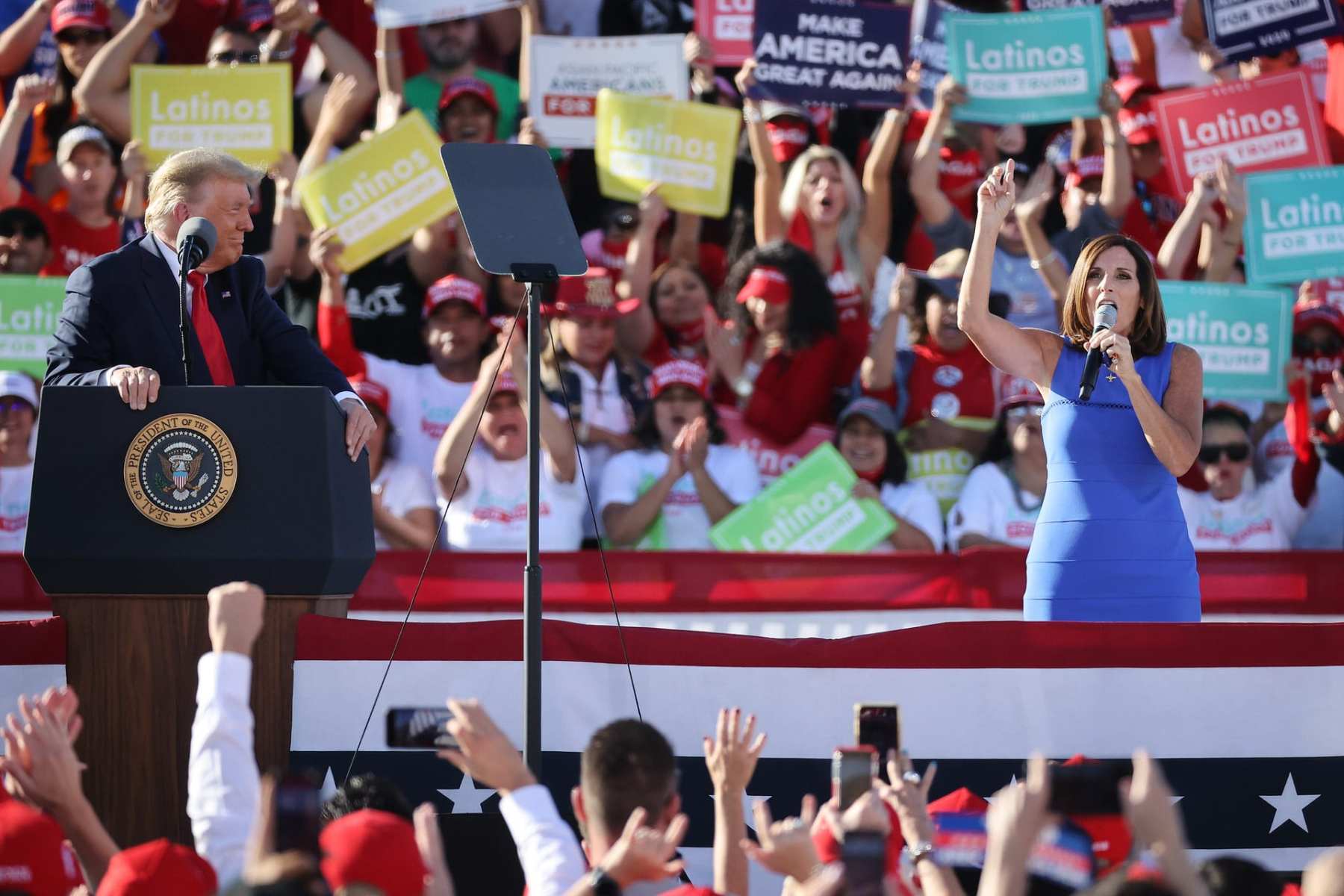We’re the only newsroom dedicated to writing about gender, politics and policy. Subscribe to our newsletter today.
Mesa, Arizona — On a recent Saturday morning in October, less than two weeks ahead of the election, Betsy Chandler arrived at the Mesa Convention Center and set up a tent to hand out signs promoting Democratic candidates at the early voting center.
Cases of COVID-19 were again on the rise in the state, and specifically within Maricopa County, which includes Arizona’s largest city, Phoenix, and suburbs such as Mesa. Chandler and the other volunteers decided that it would be too risky to continue talking to voters in person, even while wearing masks and other protective equipment. So, after this final day at the voting center, they would revert back to phone banking, texts and literature drops in their final pre-election push as they had earlier in the year.
Even still, Chandler said as cars drove by and honked their support, she was “feeling really good” about the chances that Joe Biden would beat President Donald Trump in the state; that Democrat Mark Kelly would prevail in his race against Republican U.S. Sen. Martha McSally; and that down-ballot candidates would fuel a Democratic takeover at every level of government in a state and county where Republican politics have long dominated.
Even one of these feats on its own would be a striking political victory. If two or three occur, it will be a Democratic coup d’état fueled by women like Chandler, whose increased participation promises to reshape Arizona politics for years to come.
“I keep hearing the word ‘exhausted,’” Chandler said of her conversations with voters, particularly the women who are “bearing the brunt” of a pandemic that has closed their children’s schools and made even a short trip to the grocery store a risk calculation. It has kept grandparents in this retirement destination away from their grandchildren. Chandler has not seen her own 31-year-old daughter, who lives in the state, since March. Women are “fed up,” she said.
“When early voting began, one woman on the very first day came up to me and she said: ‘I took three buses to get here when it opened — I’ve been waiting a long time to do this,’” Chandler said, describing the voter as elderly and Latina.
Since she started Democratic organizing two years ago in her state legislative district, Chandler said the number of volunteers has increased to about 120 from 20, and more than half are women. The district had about 140,000 registered voters in 2018, and Chandler and fellow volunteers have handed out 22,000 Democratic sample ballots, sent 300,000 texts and phone banked seven days a week. “We aren’t messing around,” she said.
And there are signs that this coalition of women — made up of invigorated liberals, newly engaged Latinas, and disaffected suburban independents and Republicans — may pull it off.
Cracks have started to form in the state-level trifecta that Arizona Republicans have enjoyed since 2009, when they gained control of the governor’s office. (The GOP has held both the state House and Senate for roughly 50 years.)
In the 2018 elections, Democrats picked up four seats in the state House. They need two more this year to control that chamber and three more to control the state Senate. The nonpartisan Cook Political Report has forecast Arizona’s state Senate as a “toss up” contest and earlier this month moved the House from that category to “leans Democratic.”
Republican Gov. Doug Ducey is not up for reelection this year, but his approval ratings could portend difficulty for Republicans running in other statewide races. In a Suffolk University/USA Today poll taken earlier this month, just 35 percent of Arizonans — 42 percent of men and 29 percent of women — approved of his performance.
A second U.S. Senate seat in Arizona is also slipping from the GOP’s grasp.
In 2018, Democrat Kyrsten Sinema defeated McSally by just 2.4 points, boosted by the 16 percent of Republican women who crossed the aisle that year, compared to about 6 percent of Republican men. McSally was appointed to her seat by Ducey in 2019 after longtime Republican Sen. John McCain’s death.
She’s now facing a tough reelection against Kelly, a former U.S. Navy captain and astronaut married to Gabrielle Giffords, a former U.S. representative who survived an assassination attempt. Kelly has proven to be a strong candidate, and he is leading McSally, who was a member of the U.S. Air Force and was the first woman to fly in combat, in a state where veterans make up 7 percent of the workforce. Some polls show Kelly winning women by more than 15 points.
McSally, recognizing the state’s pivotal role in national politics, said at a recent campaign event that Arizona is “ground zero for the Senate” and the presidential race.
No Republican has ever won the presidency without Arizona. Bill Clinton’s 1996 victory in Arizona was the only time a Democrat had won the state since 1948. But Trump and Biden have frequently visited the state, a sign that it is up for grabs this year.
The margins by which Republicans win have been shrinking. McCain, who enjoyed a home state advantage, won by 8.5 points in 2008. Mitt Romney captured a slightly larger margin, winning the state by 9 points in 2012. But that dwindled significantly in 2016, when Trump won the state by only 3.5 points in his race against Hillary Clinton.
Biden is leading Trump in most Arizona polls but typically by a smaller margin than Kelly is leading McSally.
At a Trump rally in the Maricopa County city of Goodyear this week, the president put distance between himself and McSally, a loyal supporter, by limiting her time on stage. “Come up fast! Fast! Fast! Come on, quick! You’ve got one minute … one minute, Martha! They don’t want to hear this, Martha. Come on, let’s go. Quick, quick, quick!”
The exchange dominated news coverage of the event.
Arizona’s rapid growth has changed the demographics of the state and, increasingly over the past few years, its politics. The state is one of the fastest-growing in the country. Maricopa, where 4.5 million of the state’s 7.3 million residents live, added more people from 2010 t0 2018 than any other county except Harris in Texas, which includes the Houston metropolitan area.
Retirees from the Midwest have long settled in the state’s Phoenix-area retirement communities. Younger residents have moved from California and other Western states, drawn by Arizona’s relatively low cost of living and employment opportunities. The growth is expected to result in Arizona adding a tenth U.S. House seat after the 2020 census.
In 2000, Arizona’s electorate was 75 percent White; in 2018, that figure had dropped to 68 percent, according to the Pew Research Center. Over the same period, the Latinx share of the electorate grew from 15 percent to 24 percent. Roughly three quarters of Latinx voters went Democratic in 2018, a shift that helped power Sinema’s victory. The advocacy group Mi Familia Vota says it has registered 185,000 new voters in Arizona this year.
“We’ve changed a great deal. We’re a very transient state now, something like 250 families a day are moving into Arizona from elsewhere in the United States. That brings with it different political views, different interests, different ideas,” said Cindy McCain, a prominent Republican in the state due to her marriage to Sen. John McCain.
Headed into the election, Arizona’s electorate is 35 percent registered Republicans, 32 percent Democrats and 32 percent politically independent. There has been a slight shift from independents to Democrats since the 2016 election.
As the state’s demographics have changed, becoming more friendly to Democrats, Arizona’s Republican Party has grown more conservative. In 2010, the state passed an anti-immigration law that was, at the time, the strictest in the country. Senate Bill 1070 required non-citizen immigrants to carry immigration paperwork at all times or face a federal misdemeanor charge. The U.S. Supreme Court tossed out most of the law, but it has nevertheless continued to galvanize liberal resistance.
In 2016, the same year that Trump won Arizona, Maricopa County rejected the reelection bid of its longtime Republican sheriff, Joe Arpaio, who had become a national lightning rod over his hardline immigration stances. Arpaio had backed S.B. 1070 and claimed without evidence that former President Barack Obama’s birth certificate had been forged. He faced numerous allegations of police misconduct and was convicted of contempt of court in a case where his department was found to have racially profiled Latinx individuals. Trump pardoned Arpaio in 2017.
Cindy McCain is a high-profile archetype for the type of suburban Republican woman who is increasingly crossing the aisle in Arizona to back Democrats. She said she will vote for Biden this year — the first time she has endorsed or even voted for a Democrat for president. “I’m going to remain a Republican, but my party has left me right now and I think our party is misguided in many ways,” she told The 19th in an interview.
Arizona has a long history of voting by mail, and the number of voters casting early ballots has broken records amid the COVID-19 pandemic. In Maricopa County, more than 2 million early ballots were requested this year. As of Wednesday, about 1.26 million had been returned — already more than the total number of early voters in 2016 — and, for the first time in state history, Democrats are outpacing Republicans in early voting.
The enthusiasm among Democrats does not surprise Anna Tovar, the mayor of Tolleson, a small city west of Phoenix that is more than 80 percent Latinx. Tovar, who was also a member of the state Senate from 2013 to 2015, is running for a seat on the Arizona Corporate Commission this year. On the same weekend that Chandler was handing out signs and candidate literature at Mesa’s early-voting site, Tovar met with other Democratic candidates and a coalition of progressive groups in a community park across town to knock on doors in Maricopa County’s heavily Latinx areas.
Tovar said since being elected mayor in 2016, she has “worked to increase voter turnout in our community.” The “vast majority” of her constituents are essential workers in the pandemic who “did not have the luxury” to shelter in place. Whenever someone contacts her about Wi-Fi or rent, “one thing I ask at the end of every phone call is: Are you registered to vote?’” she said.
Tovar said she has “strategically targeted” voter outreach to “our mothers and our grandmothers” due to the roles they plan in Latinx households. “They can be the leaders in how we turn out our communities,” she said.
Chandler said that no matter who she talks to, whether it’s fellow middle-aged White women, Latinas, or the Republican and independent women who have approached her due to their disillusionment with Trump, everyone agrees the stakes are higher than normal this year.
“Women really seem to be voting for their lives,” she said.






